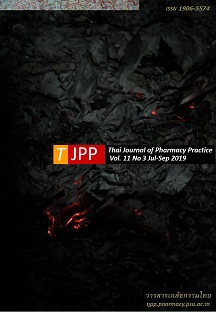Regimens and Clinical Outcomes of Antimicrobial Uses in Hospital-Acquired Pneumonia Caused by Drug Resistant Acinetobacter baumannii
Main Article Content
Abstract
Objective: To study antimicrobial regimens, clinical outcomes and adverse drug reactions (ADRs) of antimicrobials for the treatment of hospital-acquired pneumonia caused by multidrug-resistant Acinetobacter baumannii (MDR A. baumannii) and extensively drug-resistant A. baumannii (XDR A. baumannii). Methods: The researchers retrospectively collected the data from electronic medical records of patients in the medical ward at Maharat Nakhon Ratchasima hospital from July-December 2016 Results: There were 94 elegible patients in the study. A total of 17 antimicrobial regimens were found with the combination of colistin and carbapenems being the most commonly used antimicrobial regimen (31 patients or 33.0%). Four of those receiving colistin and carbapenems were clinically improved after 72 hours of antimicrobial treatment. At the end of antimicrobial treatment, 8 were clinically cure and 22 were dead. Clinical outcomes were not significantly different between those with and without colistin in the treatment. Mortality rate was significantly lower with combination therapy compared with monotherapy (P=0.049). ADRs were found in 13 patients (13.8%). The majority of ADR was nephrotoxicity found in 11 out of 37 patients receiving colistin injection. Conclusion: The most commonly used antimicrobial regimen for hospital-acquired pneumonia with MDR A. baumannii and XDR A. baumannii infections was a combination of colistin and carbapenem. However, clinical outcomes were rather poor. Those receiving intravenous colistin should be monitored for nephrotoxicity.
Article Details
ผลการวิจัยและความคิดเห็นที่ปรากฏในบทความถือเป็นความคิดเห็นและอยู่ในความรับผิดชอบของผู้นิพนธ์ มิใช่ความเห็นหรือความรับผิดชอบของกองบรรณาธิการ หรือคณะเภสัชศาสตร์ มหาวิทยาลัยสงขลานครินทร์ ทั้งนี้ไม่รวมความผิดพลาดอันเกิดจากการพิมพ์ บทความที่ได้รับการเผยแพร่โดยวารสารเภสัชกรรมไทยถือเป็นสิทธิ์ของวารสารฯ
References
2. Thummeepak R, Kitti T, Sitthisak S. Epidemiology and virulence factors of multidrug-resistant Acineto bacter baumannii. Thammasat Medical Journal 2015; 15: 322-32.
3. Carey RB, Banerjee SN, Srinivasan A. Multidrug-resistant Acinetobacter infections, 1995–2004. Presented at the 46th Interscience Conference on Antimicrobial Agents and Chemotherapy; 2006 Sep 27-30; San Francisco, USA.
4. Kuo SC, Chang SC, Wang HY, Lai JF, Chen PC, Shiau YR, et al. Emergence of extensively drug-resistant Acinetobacter baumannii complex over 10 years: nationwide data from the Taiwan Surveil lance of Antimicrobial Resistance (TSAR) program. BMC Infect. Dis. 2012; 12: 200.
5. Saelao S, Utiswannakul A. Therapy for patient with multidrug-resistant Acinetobacter baumannii. Journal of Health Research 2008; 22: 131-6.
6. National Antimicrobial Resistance Surveillance of Thailand. Antibiogram [online]. 2000. [cited Oct 10, 2016]. Available from: narst.dmsc.moph.go.th/antibi ograms/anti2000.pdf
7. Visalsawadi J. Increasing of carbapenem-resistant and multiple drug-resistant Acinetobacter bauman nii in Maharat Nakhon Ratchasima Hospital. Maharat Nakhon Ratchasima Hospital Medical Bulletin 2008; 32: 19-28.
8. Lee YT, Tsao SM, Hsueh PR. Clinical outcomes of tigecycline alone or in combination with other antimicrobial agents for the treatment of patients with healthcare-associated multidrug-resistant Acine tobacter baumannii infections. Eur J Clin Microbiol Infect Dis 2013; 32: 1211-20.
9. Sirijatuphat R, Thamlikitkul V. Preliminary study of colistin versus colistin plus fosfomycin for treatment of carbapenem-resistant Acinetobacter baumannii infections. Antimicrob Agents Chemother 2014; 58: 5598-601.
10. Kim WY, Moon JY, Huh JW, Choi SH, Lim CM, Koh Y, et al. Comparable efficacy of tigecycline versus colistin therapy for multidrug-resistant and extensively drug-resistant Acinetobacter baumannii pneumonia in critically ill patients. PLoS One 2016; 11: 1-11.
11. Viehman JA, Nguyen HM, Doi Y. Treatment options for carbapenem-resistant and extensively drug-resistant Acinetobacter baumannii infections. Drugs 2014; 74: 1315-33.
12. Koomanachai P, Tiengrim S, Kiratisin P, Thamli kitkul V. Efficacy and safety of colistin (colistime thate sodium) for therapy of infections caused by multidrug-resistant Pseudomonas aeruginosa and Acinetobacter baumannii in Siriraj Hospital, Bangkok , Thailand. Int J Infect Dis 2007; 11: 402-6.
13. Kalin G, Alp E, Akin A, Coskun R, Doganay M. Comparison of colistin and colistin/sulbactam for the treatment of multidrug resistant Acinetobacter baumannii ventilator-associated pneumonia. Infec tion 2014; 42: 37-42.
14. Tuon FF, Rocha JL, Merlini AB. Combined therapy for multi-drug-resistant Acinetobacter baumannii infection--is there evidence outside the laboratory? J Med Microbiol 2015; 64: 951-9.
15. Yilmaz GR, Guven T, Guner R, Kocak Tufan Z, Izdes S, Tasyaran MA, et al. Colistin alone or combined with sulbactam or carbapenem against A. baumannii in ventilator-associated pneumonia. J Infect Dev Ctries 2015; 9:476-85.
16. Puttilerpong Ch, Chawanasit W, Laohawaleesan W, Rungsang W, Ritteeverakul P. Antimicrobial use in hospital-acquired pneumonia with multidrug -resistant Acinetobacter baumannii at King Chula longkorn Memorial Hospital. Thai Pharmaceutical and Health Science Journal 2011; 6: 32-8.
17.Gilbert DN, Chambers HF, Eliopoulos GM, Saag MS, editors. The Sanford Guide to Antimicrobial Therapy 2015. 45th ed. Virginia: Antimicrobial Therapy; 2015.
18. Maharat Nakhon Ratchasima Hospital. The guide to prescription and monitoring for nephrotoxic drugs [online]. 2016. [cited Sep 15, 2016]. Available from: www.medkorat.in.th/admin/ckfinder/userfiles/files/Guidelines%20for%20drug%20use.pdf
19. Maharat Nakhon Ratchasima Hospital. The guide to prescription sulbactam for the treatment of Acinetobacter baumannii [online]. 2016. [cited Sep 15, 2016]. Available from: www.medkorat.in.th/adm in/ckfinder/userfiles/files/Sulbactam.pdf
20. Maharat Nakhon Ratchasima Hospital. Fosfomycin Disodium inj [online]. 2016. [cited Sep 15, 2016]. Available from: www.medkorat.in.th/admin/ckfinder/ userfiles/files/fosfomycinUPDATE%2023%20DEC%202015.pdf
21. Knaus WA, Draper EA, Wagner DP, Zimmerman JE. APACHE II: A severity of disease classification system. Crit Care Med 1985; 13: 818–29.
22. Sun HY, Chen YC, Wang YW, Gau CS, Chang SC. A prospective study of antimicrobial-related adverse drug reactions in hospitalized patients. J Microbiol Immunol Infect 2008; 41: 151-59.
23. Hartzell JD,Neff R, Ake J, Howard R, Olson S, Paolino K, et al. Nephrotoxicity associated with intravenous colistin (colistimethate sodium) treat ment at a tertiary care medical center. Clin Infect Dis 2009; 48:1724–28.
24. Wang HE, Muntner P, Chertow GM, Warnock DG. Acute kidney injury and mortality in hospitalized patients. Am J Nephrol 2012; 35: 349–55.
25. Brown JR, Rezaee ME, Marshall EJ, Matheny ME. Hospital mortality in the united states following acute kidney injury. Biomed Res Int. 2016; 2016: 1-7.
26. Kallel H, Hergafi L, Hakim A, Dammak H, Chelly H, Hamida CB, et al. Safety and efficacy of colistin compared with imipenem in the treatment of ventilator–associated pneumonia: a matched case- control study. Intensive Care Med 2007;33: 1162-7.


